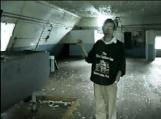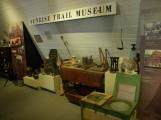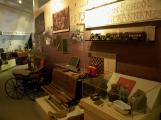1
Ray Carruthers who started the Sunrise Trail Museum20th - 21st Centuries.1914-2001
Tatamagouche, Nova Scotia Canada
 Credits:
Credits:North Shore Archives
2
The Sunrise Trail Museum was really established as a result of Ray Carruthers (1914 -2001) deciding to show a collection of his artefacts in a marquee during the Festival of the Arts . This festival was held for a number of years on the playing fields opposite the North Colchester High School, in Tatamagouche. during the 1950' s and 60's. Ray charged admission and the popularity of his collection led him to acquire the former Post Office building (once a Nissen hut from the World War 2 camp site at Debert.), situated on Main Street.3
Sunrise Trail Museum20th Century 1960's
Tatamagouche, Nova Scotia Canada
 Credits:
Credits:North Shore Archives
4
The original Sunrise Trail Museum which opened in 1958For a number of years the museum collection expanded and included evidence from the days of the Mi'kmaq, the 18th Century Acadians, and the Montbelairds, then the various arrivals from Scotland and elsewhere in Europe, during the 1800's.
In time,as more local items were collected, space for display became a challenge and there was little in the way of storage space.
5
Sunrise Trail Museum - early displays20th Century. Circa 1980
Tatamagouche, Nova Scotia Canada
 Credits:
Credits:North Shore Archives
6
During the early 1970's the old museum was closed for renovations; with the help of a Federal Government grant a central wall was installed that divided the former space into two parts, thus providing more wall space and increasing the exhibit area . Displays were improved, with sections devoted to the Mi'kmaq, Acadians, shipbuilding, farming, home life.........Visitors could follow a 'historic trail' round the museum. Glass cases rarely covered exhibits, - many as displayed in the photograph,- so artefacts were a little vunerable to being touched and handled.Labels were in English, French and German wherever possible. and the Curator and assistants were all volunteers delighting in talking with visitors about the objects.
By the 1980's the building was beginning to need attention.
In the 1990's storage was restricted to the room at the rear which was filled with a conglomeration of large, sometimes rusting houshold items too large to display; there was another small room with access to part of the attic, - these areas housed parts of quilting tables, weaving looms and spinning wheels; and there was a cupboard with stuffed birds in a rather unhappy state, plus some sad dolls..
Damp, moth, and mice were finding their way in
Floor boards started to rot. in the main building The cost of upkeep both to the interior and exterior became a problem although the volunteer staff did their best.. Maintenance was also beginning to threaten the museum; money was dependant on visitors, and with no parking facility, and no access for the physically challenged, something really had to be done.
In 2007 Verna Lowden - the then President, said..' that the old museum had served its purpose and the community well, but it was going down hill. The new facility at the Creamery would enhance the presentation and expand displays...' It was at this time that the museum took on the task of sorting the Roy Kennedy Historical Collection and Artefacts.
7
Creamery interior before any conversions20th Century 1993
Tatamagouche, Nova Scotia Canada
 Credits:
Credits:Museum of Industry, New Glasgow NS
8
This interior picture of the Creamery was taken around 1992/3 when the building first came into the hands of the community. Showing the second floor at that time and cleared of equipment, the sloping roof, was quite a challenge for the museum designers and could easily have caused a loss of potential display space. As a result of the renovations and consequent designs the Heritage Centre won a National Award and visitors often exclaim in delight on entering the main floors.9
Creamery Square Heritage Centre today. Medical Section19th and 20th Centuries
Tatamagouche, Nova Scotia Canada
 Credits:
Credits:Creamery Square Heritage Society
10
In the new Heritage Centre the displays also have very few covers, meaning that a volunteer or a Summer student needs to be aware when visitors are moving round - the desire to touch is evident.The photograph is part of the local medical scene, with equipment from the original Lillian Fraser hospital, dental chair and tools together with Dr Roach's fitted medical bag; he was the village doctor for many years and did anything from simple operations, to dental extractions.
11
CSHC - Everyday items in the home19th and 20th Centuries
Tatamagouche, Nova Scotia Canada
 Credits:
Credits:Creamery Square Heritage Society
12
At some stage the museum records seem to have got into a mess; perhaps stored for a while in the back room of the old museum they became damp and 'eaten' Fortunately there are still volunteers around who remember many of the artefacts and their history. When the move to the Heritage Centre took place, it was difficult to keep some of the identifying tags on objects; not permanently affixed, they became tangled or fell off - It has been a long process identifying some of the objects, but by using former volunteer knowledge,some existing records and early photographs, and artifacts are now correctly labelled.The move to the new premises was an exciting one- with families of mice very annoyed at being disturbed in the store room.
The photograph includes some of the everyday articles used in the early homes of the area- including a fireless oven which most people think is a 'two seater'.
13
CSHC -To do with children - toys and school days19th and 20th Centuries
Tatamagouche, Nova Scotia Canada
 Credits:
Credits:Creamery Square Heritage Society
14
The old museum had no parking area, and no access for wheelchairs. Elderly might find it difficult to manage the approach. Yet there was considerable fondness for the museum, and it was with reluctance that the decision was made to move to the new Heritage Centre. Practicality and common sense won.Local schools from the 19th and early 20th century are featured, with visitors sometimes finding a family member or even themselves in the group photographs on display. Various toys and books and young people's amusements from an earlier age are also shown.